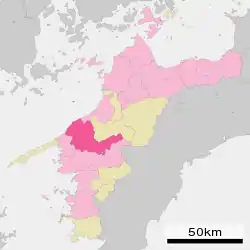Ōzu, Ehime
Ōzu (大洲市, Ōzu-shi) is a Japanese city of about 43,000 inhabitants located in the southern half of Ehime Prefecture.

Ōzu
大洲市 | |
|---|---|
 Flag  Emblem | |
 Location of Ōzu in Ehime Prefecture | |
 Ōzu Location in Japan | |
| Coordinates: 33°30′N 132°33′E | |
| Country | Japan |
| Region | Shikoku |
| Prefecture | Ehime Prefecture |
| Government | |
| • Mayor | Ninomiya Takahisa (since March 2018) |
| Area | |
| • Total | 432.24 km2 (166.89 sq mi) |
| Population (January 31, 2020) | |
| • Total | 42,655 |
| • Density | 98.68/km2 (255.6/sq mi) |
| Time zone | UTC+09:00 (JST) |
| City hall address | 690-1 Ōzu, Ōzu-shi, Ehime-ken 795-8601 |
| Website | www |
History
Ōzu is a medieval castle-town located by the Hiji River. The city developed as the political centre of the Ōzu domain (大洲藩, Ōzu-han) during the Edo period. The keep of the castle, demolished in 1888, was rebuilt with original techniques and materials in 2004.
Outline
− End of Kamakura period (early 14th century), first defensive structure on the banks of the Hiji River.
− Early Azuchi–Momoyama period (late 16th century), completion of the current Ōzu Castle.
− 1617: arrival of Katō Sadayasu (加藤 貞泰) from Yonago province. He became the first daimyō of the Katō clan (governors of the Ōzu domain for 13 generations, until the onset of the Tokugawa shogunate).
− Meiji and Taishō periods (late 19th century, early 20th century) saw great economic expansion due to thriving silk and Japanese wax candles (和蠟燭, warōsoku) industries. A robust timber trade also occurred during this time. (The Hiji River served as the artery articulating these transactions).
− Early 1900s: Notable urban regeneration with numerous works of architecture financed by local merchants. Among them, Kōuchi Torajiro (河内 寅次郎)'s Garyu Villa (a sukiya style tea house), Matsui Kunigoro's (松井國五郎) residence (松井邸, Matsu-tei) or Murakami wax producer estate (村上邸、Murakami-tei).
− 1913: inauguration of the Hijikawa Bridge (肱川橋, Hijikawa-bashi).
− 1918: inauguration of the railroad line connecting Ozu with Nagahama, harbour town at Hiji River's mouth (21 km length).
− 1935: inauguration of the Nagahama Great Bridge (長浜大橋, Nagahama Ōhashi), a bascule bridge at the mouth of the Hiji River. The high volume and importance of river traffic required a retractable solution for the new bridge.
Post-war political reorganization
- 1954: political merging of the town of Ōzu (大洲町, Ōzu-chō) with Hirano (平野村, Hirano-mura), Awazu (粟津村, Awazu-mura), Miyoshi (三善村, Miyoshi-mura), Kamisukai (上須戒村, Kamisukai-mura), Minamikume (南久米村, Minamikume-mura), Sugeta (菅田村, Sugeta-mura), Niiya (新谷村, Niiya-mura), Yanagisawa (柳沢村, Yanagisawa-mura) and Ōkawa (大川村, Ōkawa-mura) villages.
- 2005: January 11 neighboring Nagahama, Hijikawa, and Kawabe municipalities merged to create the current Ōzu municipality.
Heritage
Ōzu's flourishing silk and wax industries brought great wealth and prosperity, particularly at the turn of 20th century. Refinement and cultural discernment followed suit. This resulted in a thriving urban environment of various historical layers, remnants of which are still standing:
-Ōzu castle (大洲城, Ōzu-jō) (four of its turrets were declared Important Cultural Property in 1957)
-Nyohō Temple (如法寺, Nyohō-ji) Buddhist Temple of the Rinzai sect founded in 1669 by monk Bankei (盤珪永琢 Bankei Yōtaku) together with Katō Yasuoki, second daimyo of the Katō clan. (Important Cultural Property since 1992). Its zen meditation hall displays a Siddhattha Gotama (釈迦如来像, Shakanyorai-zō) sculpture, flanked by elevated tatamis, a rather unusual setting in zazen (座禅) dedicated spaces .
-Ōzu Akarenga-kan (おおず赤煉瓦館)or Red Brick Wall. Main branch of former Ōzu Commercial Bank (大洲産業銀行, Ōzu Sangyō Ginkō) built in 1901, evoking Western architecture. Municipal Important Asset.
-Garyū Sansō (臥龍山荘) Set of three tea pavilions within a lavish roji (路地) -tea ceremony garden- overhanging the Hiji River. Built by silk and tea trade champion Torajiro (河内 寅次郎, Kōuchi Torajiro) as a personal retreat. It doubled as a Noh Theatre stage and was berth of the local kaketsukuri (懸け造り) architecture style. Completed between 1901 and 1907. (Important Cultural Property from 2016)
-Nagahama Great Bridge (長浜大橋, Nagahama Ōhashi) completed in 1935, Inscribed as Important Cultural Property by the Agency for Cultural Affairs in 2014, it is the oldest bascule-bridge in Japan still in operation. Traces of US forces' gunfire still punctuate parts of the structure.
Gallery
 Ōzu Castle
Ōzu Castle Rice paddies in Ōzu
Rice paddies in Ōzu Downtown Ōzu as seen from atop Mount Tomisuyama
Downtown Ōzu as seen from atop Mount Tomisuyama Nagahama's famous drawbridge
Nagahama's famous drawbridge
References
External links
 Media related to Ōzu, Ehime at Wikimedia Commons
Media related to Ōzu, Ehime at Wikimedia Commons Geographic data related to Ōzu, Ehime at OpenStreetMap
Geographic data related to Ōzu, Ehime at OpenStreetMap- Visit Ozu [Official Homepage (JP)]